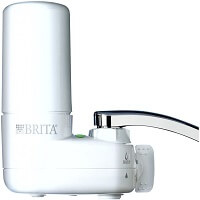The majority of households across America, and other well developed countries, already enjoy a supply of treated tap water. However, it may come as a surprise to learn that as many as four in ten Americans prefer to utilize some form of water treatment within their home, in order to remove additional contaminants. Because they are easily accessible, and simple to use, faucet filters are a widely used form of water filtration. While they may be easy to buy, and simply to use, they may not be the best option for your family. If you find yourself doubting the effectiveness of your faucet filter, let’s explore a few questions:
- Are Faucet Filters Effective?
- Are Faucet Filters Worth the Investment?
- Should I Purchase an Expensive Unit?
Understanding Filtering VS Purifying Water
Far too often, people unintentionally compromise their own health by putting less effort toward their drinking sources. Although some individuals consider the terms filtering and purifying to be the same thing, that couldn’t be further from the truth. The truth is, filtration and purification differ greatly from one another.
Water Filtration
Removes large contaminants from water that has already been processed and treated. This is helpful with water that was treated with chemicals such as bleach, in order to remove unpleasant scents and tastes that may remain. Additionally, some treated water may still contain lead, and chlorine, which can carry serious health consequences. Faucet filters and pitcher filters are also capable of removing dirt, dust, cysts, germs, and even mercury, to name a few.
Water Purification
When water has been treated improperly, or left untreated, it will benefit from water purification through an RO system, or the like. This means that purification is capable of removing virtually everything that’s harmful to human health, even if they’re tiny – such as arsenic. This type of water treatment is extremely beneficial to areas where access to safe drinking water may be restricted or unavailable.
How Effective is Tap Water Filtration?
The method and means by which a faucet water filtration is utilized makes all the difference in overall effectiveness. In areas where treated tap water is available, you can expect effective filtration results, capable of removing lead and chlorine. Some forms of sediment might also be removed in small amounts. Overall smell and flavor will also improve, as many of the contaminants that affect taste quality are easily filtered out. Homeowners should expect a 20% improvement in their water quality through the use of a water faucet filtration device. However, for areas suffering from highly contaminated, or otherwise dangerous, water conditions, a tap water filter simply won’t cut it – turn to an RO system, instead.
How Do Faucet Filters Work?
Since we have now provided a full picture of what filtering vs purifying drinking water looks like, you can have a greater understanding of how faucet filters operate. Essentially, homeowners can rely on an affordable faucet filter to remove solid contaminants like sand and dirt, various chemicals like chlorine, and metals like lead. Overall, users will notice a marked improvement in taste and smell if they were initially cringing at the thought of drinking water laced with bleach.
These water filter devices are easy to install and use, requiring a simple mount directly onto your sink faucet. Typically they are comprised of metal, but may also utilize a plastic housing. The internal aspects feature a filter cartridge, which usually provides filtration through activated carbon. Depending on the manufacturer, style, and price, there may be one or more stages water is filtered through.
Sediment Removal
Water flows through a non-woven screen whenever a faucet is turned on. This screen is wrapped around a filter cartridge, typically filled with activated carbon. This provides the means to trap sand, sediment, and dirt, preventing it from flowing through to your cup.
Activated Carbon Block
After water has gone through the screen, it flows through activated carbon, and zeolite. Water contaminants are trapped as it passes through nooks and crannies of the carbon block, effectively removing various chemicals. On the downside, once these porous surfaces are filled, filtration effectiveness will drop before stopping completely.
Activated Carbon Filter (ACF)
This type of carbon filtration utilizes a microporous material in a fiber shape, with a structure that’s well-defined and particularly porous. This provides an absorption rate anywhere from 100 to 1000 times faster than other traditional methods for organic gases. ACF tends to cost more on the expensive side, due to the use of high quality material and input cost associated with newer tech. However, this type of filtration features a long service life, and costs under 10 centers each day for unlimited healthy, safe drinking water.
Ceramic Filter
Mainly used for filtration, ceramic filters are capable of removing pollutants, organic chemicals, chlorine, while improving odor and taste. Compared to other types of filtration, such as ACF or even CTO, the effect of a ceramic filter is poor. This is simply due to the fact that it is incapable of removing heavy metals and various inorganic salts.
Chemical Removal
While activated carbon performs well enough at removing some contaminants, it simply cannot do well against calcium and magnesium, to name a few. This is where the removal of chemicals is such an important aspect, especially if you smell chemicals out of your tap. One easy and affordable method for the removal of chemicals, is to allow water to trickle through slowly, thereby producing a higher removal rate.
Top Recommendations for Faucet Filtration
Waterdrop is a well-known professional water filtration brand. The ACF Faucet Filtration System is tested and certified by NSF International against NSF/ANSI standard 42 for the overall reduction of chlorine, foul tastes and odors, and to NSF/ANSI 372 for lead-free material.
With 6 stages of filtration, the Waterdrop ACF Faucet Filtration System has been proven to effectively reduce lead, fluoride, and chlorine commonly found in tap water. The activated carbon fiber in particular is efficient at removing up to 93% of chlorine, taste and odor, and many other contaminants. A simple design provides quality filtered water to your family, through the use of simple tap water. With leak-proof technology, the Waterdrop means you can fit this product to your faucet with any of the included adapters. The Waterdrop Facebook homepage also sends out coupons on a regular. Simply follow @waterdropdirect for more information in regard to discounts.
In Conclusion
Should you ever come into contact with someone wondering “how effective are the faucet filters?”, you will be prepared to explain the entire situation. Regardless of how clean they consider their tap water, they are sure to taste the difference in the overall reduction of lead and chlorine with the simple installation of a Waterdrop faucet water filter.

